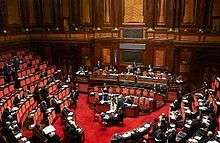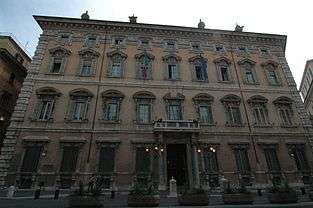Senate of the Republic (Italy)
| Senate of the Republic Senato della Repubblica | |
|---|---|
 | |
| Type | |
| Type |
Upper house of the Parliament of Italy |
| Leadership | |
President of the Senate | |
| Structure | |
| Seats |
315 elected senators + 5 lifetime senators |
 | |
Political groups |
Government (162) Government support (18)
Opposition Parties (140) |
| Elections | |
Last election | 24–25 February 2013 |
| Meeting place | |
 | |
| Palazzo Madama, Rome | |
| Website | |
| http://www.senato.it | |
 |
| This article is part of a series on the politics and government of Italy |
| Constitution |
|
Legislature |
|
| Foreign relations |
|
Related topics |
The Senate of the Republic (Italian: Senato della Repubblica) is a house of the bicameral Italian Parliament (the other being the Chamber of Deputies). It was established in its current form on 8 May 1948, but previously existed during the Kingdom of Italy as Senato del Regno (Senate of the Kingdom), itself a continuation of the Senato Subalpino (Subalpine Senate) of Sardinia established on 8 May 1848. Members of the Senate are styled Senator or The Honourable Senator (Italian: Onorevole Senatore)[1] and they meet at Palazzo Madama, Rome.
Composition
The Senate consists of 315 elected members, and as of 2016 five senators for life. The elected senators must be over 40 years of age, are elected by an electorate composed of Italian citizens aged 25 or over and, save for six senators who represent Italians living outside Italy, are elected on a regional basis. The senators for life are composed of former Presidents of the Italian Republic who hold office ex officio, and up to five citizens who are appointed by the president "for outstanding merits in the social, scientific, artistic or literary field".
The five current life senators are:[2]
- Of law as former President of the Republic:
Giorgio Napolitano - One economist (who served as Prime Minister in 2011-13):
Mario Monti (SC) - One Pritzker Prize-winning architect:
Renzo Piano (independent, member of the Mixed Group) - One Nobel Prize-winning particle physicist and inventor:
Carlo Rubbia (independent, member of SVP-UV-PATT-UPT-PSI-MAIE) - One academic (the third female lifetime senator in Italian history):
Elena Cattaneo (independent, member of SVP-UV-PATT-UPT-PSI-MAIE)
The Italian Senate is unusual among European upper houses in that it has the same power as its lower counterpart (a position which is known as "perfect bicameralism"). Any law can be initiated in either house, and must be approved in the same form by both houses. Additionally, a Government must have the consent of both to remain in office.
The current term of office of the Senate is five years. Until a Constitutional change on February 9, 1963, the Senate was elected for six-year terms. The Senate may be dissolved before the expiration of its normal term by the President of the Republic (e.g. when no government can obtain a majority).
Reform
In 2016, Italian Parliament passed a Constitutional Reform bill that "effectively abolishes the Senate as an elected chamber and sharply restricts its ability to veto legislation". The bill came up for the approval of the electorate on December 4, 2016 (Italian constitutional referendum, 2016)[3] and was soundly defeated, leaving the Senate constituted as described above.
Membership
The current membership of the Italian Senate, following the latest political elections of 24 and 25 February 2013:
| Coalition | Party | Seats | ||
|---|---|---|---|---|
| Pier Luigi Bersani: Italy. Common Good |
Democratic Party (PD) | 111 | ||
| Left Ecology Freedom (SEL) | 7 | |||
| South Tyrolean People's Party (SVP) | 2 | |||
| Trentino Tyrolean Autonomist Party (PATT) | 1 | |||
| Union for Trentino (UPT) | 1 | |||
| The Megaphone – Crocetta List (IM-LC) | 1 | |||
| Total | 123 | |||
| Silvio Berlusconi: Centre-right coalition |
The People of Freedom (PdL) | 98 | ||
| Lega Nord (LN) | 18 | |||
| Great South (GS) | 1 | |||
| Total | 117 | |||
| Beppe Grillo: Five Star Movement (M5S) | 54 | |||
| Mario Monti: With Monti for Italy | 19 | |||
| Associative Movement Italians Abroad (MAIE) | 1 | |||
| Aosta Valley coalition (VdA) | Valdostan Union (UV) | 1 | ||
| Total | 315 | |||
Presidents
Under the current Constitution, the Senate must hold its first sitting no later than 20 days after a general election. That session, presided by the oldest senator, proceeds to elect the President of the Senate for the following parliamentary period. On the first two attempts at voting, an absolute majority of all senators is needed; if a third round is needed, a candidate can be elected by an absolute majority of the senators present and voting. If this third round fails to produce a winner, a final ballot is held between the two senators with the highest votes in the previous ballot. In the case of a tie, the elder senator is deemed the winner.
In addition to overseeing the business of the chamber, chairing and regulating debates, deciding whether motions and bills are admissible, representing the Senate, etc., the President of the Senate stands in for the President of the Republic when the latter is unable to perform the duties of the office; in this case the Senate is headed by a vice president.[4]
The current President of the Senate is Pietro Grasso.
Recent Presidents of the Italian Senate:
| Name | Period | Legislature | |
|---|---|---|---|
| Giovanni Spadolini (PRI) | 2 July 1987 – 16 April 1994 | X, XI | |
| Carlo Scognamiglio (FI) | 16 April 1994 – 9 May 1996 | XII | |
| Nicola Mancino (PPI) | 9 May 1996 – 30 May 2001 | XIII | |
| Marcello Pera (FI) | 30 May 2001 – 29 April 2006 | XIV | |
| Franco Marini (PD) | 29 April 2006 – 29 April 2008 | XV | |
| Renato Schifani (PdL) | 29 April 2008 – 16 March 2013 | XVI | |
| Pietro Grasso (PD) | since 16 March 2013 | XVII | |
Palazzo Madama


Since 1871, the Senate has met in Palazzo Madama in Rome, an old patrician palace completed in 1505 for the Medici family. The palace takes its name from Madama Margherita of Austria, daughter of Charles V and wife of Alessandro de' Medici. After the extinction of the Medici, the palace was handed over to the House of Lorraine. and, later, it was sold to Papal Government.
Later, in 1755, Pope Benedict XIV (whose coat of arms still dominates the main entrance) ordered major restructuring, entrusting the work to Luigi Hostini. In the following years there were installed the court offices and police headquarters. In 1849, Pius IX moved the Ministries of Finances and of the Public Debt here, as well as the Papal Post Offices. After the conquest of Rome by the newly formed Kingdom of Italy, the palace was chosen to become the seat of the Senato del Regno (Senate of the Kingdom).

Palazzo Madama and the adjacent buildings underwent further restructuring and adaptation in the first decades of the 20th century. A radical transformation which involved, among other things, the modernization of the hemicycle, the full remaking of the prospectus on Via San Salvatore and Via Dogana Vecchia, and the establishment of a connection with the adjacent Palazzo Carpegna. The latter, owned by the Senate, was entirely rebuilt in an advanced position compared to its original position. The small church of San Salvatore in Thermis, dating to the 6th century, which stood in the street to the left of the palace, was first closed, expropriated and later razed for security reasons.
The current façade was built in the mid-1650s by both Cigoli and Paolo Maruccelli. The latter added the ornate cornice and whimsical decorative urns on the roof. Among the rooms one of the most significant (and perhaps the most impressive from the political point of view) is the "Sala Maccari," which takes its name from Cesare Maccari, the artist who decorated it in 1880 and created the frescoes, among which stands out as one that depicts Cicero makes his indictment of Catiline, who listens, isolated from their seats.
The chamber where the Senate met for the first time on 27 November 1871 was designed by Luigi Gabet. A plaque on the wall behind the speaker's chair commemorates the king's address to Parliament when first convened in the new seat of government:
L'ITALIA È RESTITVITA A SE STESSA E A
ROMA • QVI E' DOVE NOI RICONOSCIAMO LA
PATRIA DEI NOSTRI PENSIERI; OGNI COSA
CI PARLA DI GRANDEZZA MA NEL TEMPO
STESSO OGNI COSA CI RICORDA I NOSTRI
DOVERI •
VITTORIO EMANVELE II
27 NOVEMBRE MDCCCLXXI
"Italy is restored to herself and to Rome... Here, where we recognise the fatherland of our thoughts, all things speak to us of greatness; but at the same time all things remind us of our duties..." - Victor Emmanuel II, 27 November 1871
Above this has been placed a plaque bearing the inscription:
IL 2 GIUGNO 1946
PER SUFFRAGIO DI POPOLO
A PRESIDIO DI PUBBLICHE LIBERTÀ
E A CERTEZZA DI PROGRESSO CIVILE
FU PROCLAMATA
LA REPUBBLICA ITALIANA
On 2 June 1946
by popular suffrage
in defence of public liberty
and a certainty of civic progress
was proclaimed
the Italian Republic
To the viewers' left stand the flags of the Italian Republic (with a ribbon embroidered with the words SENATO DELLA REPUBBLICA) and the European Union.
See also
- Parliament of Italy
- Italian Chamber of Deputies
- Senate
- Roman Senate
- Senato Italiano (TV channel)
- List of Senators for life in Italy
References
- ↑ "Onorevole: definizione e significato del termine".
- ↑ "Berlusconi allies hit out over president's lifetime senator snub". Financial Times. 30 August 2013. Retrieved 5 September 2013.
- ↑ http://www.reuters.com/article/us-italy-politics-idUSKCN0X9217
- ↑ (Italian)G. Buonomo - M. Consentino, Il Vicario del Presidente nelle Assemblee parlamentari con particolare riferimento al Senato della Repubblica italiana, in Il Parlamento, n. 10.12/1999, p. 24-37}.
External links
| Wikimedia Commons has media related to Senate of the Republic (Italy). |
- Official website (Italian)
- Official website (English)
Coordinates: 41°53′57.09″N 12°28′27.4″E / 41.8991917°N 12.474278°E